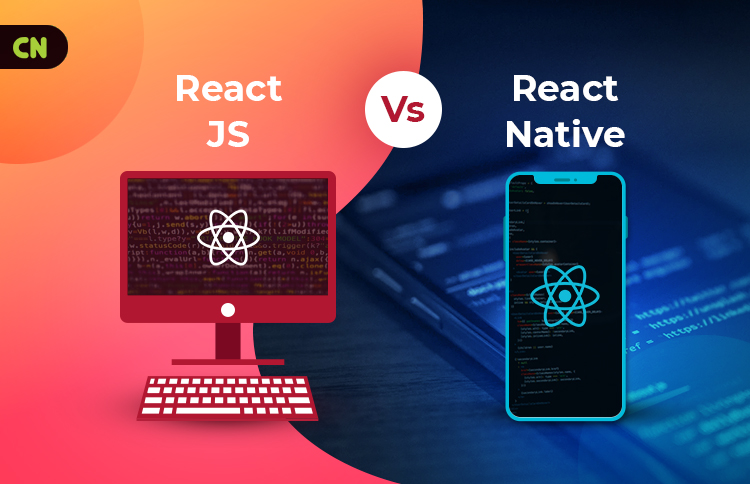ReactJS vs React Native: A Comprehensive Comparison
Table of Contents
ReactJS and React Native have revolutionized the way web and mobile applications are built. While they share a common foundation and philosophy, they are designed for different purposes.
ReactJS enables developers to create fast, dynamic, and interactive user interfaces for websites, driven by its component-based architecture and virtual DOM. As a developer, if you’re focused on mobile development, React Native lets you write mobile apps with JavaScript, while still having access to native components and performance. This saves you from learning separate languages for each platform.
So, which one should you choose? It all depends on your project goals. Whether you’re working on a web app or a cross-platform mobile app, understanding the differences and strengths of both will help you make the right choice.
This blog highlights the differences between ReactJS and React Native, along with their key features, use cases, and limitations.
What is ReactJS?
ReactJS is a JavaScript library that most developers use to build user interfaces. It focuses on creating reusable UI components, and due to this factor, developers find it easy to build scalable and maintainable web applications.
Key Features:
- Component-Based Architecture:
ReactJS is built around components. These components are small, reusable pieces of code that manage their own state. The development becomes more modular and maintainable because of this architecture. - Virtual DOM: ReactJS creates a virtual DOM to optimize performance. It updates only the parts of the UI that change. This reduces the need to re-render the entire page.
- Unidirectional Data Flow:
In ReactJS, data flows in one direction. Hence, it becomes easier to debug and maintain the application.
You may also read: How To Know That ReactJS Is The Best Fit For Your Upcoming Project?
What is React Native?
React Native is an open-source framework that allows you to develop mobile applications using JavaScript and React. Instead of rendering to the web DOM like ReactJS, it uses native mobile components, so the apps feel and perform like those built with Swift or Java.
Key Features:
- Native Performance:
React Native bridges JavaScript with native code. You can access device-specific features like the camera, GPS, and sensors. - Reusable Components:
You get the scope to leverage reusable components across platforms for consistent user interfaces and functionality. - Cross-Platform App Development:
With a single codebase, you get the scope to develop apps for both iOS and Android.
ReactJS vs React Native: Major Differences
Let’s explore the differences between ReactJS and React Native based on the following parameters:
1. Platform and Use Case
- ReactJS:
You can build dynamic, interactive user interfaces for websites with ReactJS. If you’re building a web app, be it an e-commerce site, a social network, or a real-time dashboard, ReactJS is the best choice. ReactJS is focused entirely on client-side rendering since it runs inside the web browser. - React Native:
It enables you to build native mobile applications for iOS and Android using JavaScript and React. This framework provides native app performance and gives you the chance to access platform-specific APIs.
Example:
ReactJS (Web):
This code renders a simple greeting for a web page using ReactJS in the browser:
function Greeting() {
return <h1>Hello Web!</h1>;
}
React Native (Mobile):
In React Native, the same component is used to render the greeting, but it targets mobile devices, rendering with native components:
import { Text, View } from 'react-native';
function Greeting() {
return (
<View>
<Text>Hello Mobile!</Text>
</View>
);
}
2. Rendering
- ReactJS:
ReactJS relies on the Virtual DOM, a lightweight in-memory representation of the actual DOM. When a user engages with the interface, React updates the Virtual DOM. After the update, it compares the Virtual DOM to the real DOM to make necessary changes. - React Native:
React Native works with native components instead of manipulating a browser DOM. These components (such as buttons, text inputs, etc.) are platform-specific and rendered using the native platform’s rendering system. When you use React Native, React converts your code into native code. This allows the app to run like any other native mobile application.
Example:
ReactJS (Virtual DOM):
This code shows how ReactJS updates the browser DOM by rendering the Greeting component within the web environment:
function Greeting() {
return <h1>Hello Web!</h1>;
}
const element = <Greeting />;
ReactDOM.render(element, document.getElementById('root'));
React Native (Native Components):
Here, React Native leverages native components like Text and View to render the greeting on mobile devices:
import { Text, View } from 'react-native';
function Greeting() {
return (
<View>
<Text>Hello Mobile!</Text>
</View>
);
}
3. Code Reusability
- ReactJS:
ReactJS’s code reusability is limited to the web platform. You can reuse components across different sections of your web app, but not for mobile applications. - React Native:
The cross-platform nature of React Native is one of its standout features. You can write your app once and deploy it to both iOS and Android with minimal changes. Though React Native offers shared components and logic across platforms, you may have to write some native code to optimize performance or use specific platform features.
4. Development Environment
- ReactJS:
Development with ReactJS happens in a web environment. Text editors like VSCode or Sublime and browsers like Chrome are used for debugging. The standard web development stack (HTML, CSS, JavaScript) comes into play here. ReactJS also integrates smoothly with other web technologies and tools like Webpack, Babel, and more. Hence, developers prefer using ReactJS for web development. - React Native:
React Native development involves setting up Xcode (for iOS development) and Android Studio (for Android development). You’ll still be writing JavaScript, but testing and deploying require simulators and emulators for each platform. For your convenience, React Native also provides the Expo tool for easy development and testing. If you use this tool, there’s no need for a full native environment setup.
5. Performance
- ReactJS:
For most use cases, the performance of ReactJS for web apps is excellent. This is mainly because of the Virtual DOM, which ensures efficient re-renders. However, there’s also a downside. ReactJS’s performance can degrade if you are building applications with heavy UI updates, large datasets, or lots of reactivity. - React Native:
React Native offers close-to-native performance. But it may not always match the raw performance of a fully native app. This is especially true for resource-heavy apps or those with extensive animations. In such instances, you might need to write some native code to optimize performance.
6. Learning Curve
- ReactJS:
If you have experience with JavaScript frameworks like Angular or Vue.js, you can grasp the React structure of components and props (data passed into components) easily. For quick learning, React’s developer tools and the vast ecosystem of libraries (Redux, React Router) are immensely beneficial. - React Native:
The learning curve of React Native is similar to ReactJS, but with a slight difference. You have to be familiar with mobile app navigation, platform APIs, and understand how the native mobile systems work (e.g., iOS vs Android conventions). Also, debugging in React Native is more challenging than ReactJS, especially when dealing with platform-specific issues.
7. Development Speed
- ReactJS:
Since ReactJS operates within a web environment, the development cycle is relatively fast. With tools like Hot Module Replacement (HMR), you can see changes instantly in the browser without needing to reload the page. - React Native:
React Native also has the ‘Hot Reloading’ feature, but mobile app development takes longer. More often, this is due to platform-specific nuances, hardware testing, and simulator/emulator-based debugging.
8. Community and Ecosystem
- ReactJS:
ReactJS has been around longer, and its ecosystem is well-established. You’ll find lots of libraries, community support, and ready-made components to speed up your development. The web community around ReactJS is one of the largest, with regular contributions and discussions. - React Native:
React Native’s ecosystem is also robust and growing, but it’s still catching up to ReactJS in some areas. Though there are plenty of libraries and third-party tools, you might run into platform-specific limitations, especially for newer features. However, the React Native community is highly active, with many resources and tutorials to help overcome challenges.
You may also read: Top React Libraries to Build Faster, Scalable Apps in 2025
A Quick Overview: ReactJS vs React Native
| Parameter | ReactJS | React Native |
|---|---|---|
| Platform and Use Case | Used for building dynamic, interactive user interfaces for web apps (e.g., e-commerce, social networks). | Used for creating native mobile apps for iOS and Android using JavaScript and React. |
| Rendering | Works with the Virtual DOM to efficiently update the real DOM for web apps. | Works with native components and converts code into native code for mobile devices. |
| Code Reusability | Limited to web platforms; components can be reused across different sections of a web app. | Cross-platform; write once, deploy on both iOS and Android with minimal changes. |
| Development Environment | Development occurs in a web environment using text editors like VSCode and tools like Webpack and Babel. | Requires setting up Xcode (iOS) and Android Studio (Android), with tools like Expo for easier development. |
| Performance | Excellent for most web apps; performance may degrade with heavy UI updates or large datasets. | Close-to-native performance, but may not match the raw performance of native apps, especially with heavy animations. |
| Learning Curve | Easy for developers familiar with JavaScript frameworks (e.g., Angular, Vue.js). | Slightly steeper due to mobile-specific concepts and platform APIs (iOS vs Android). |
| Development Speed | Fast development cycle with tools like Hot Module Replacement (HMR) for instant updates. | Slower development due to platform-specific nuances and the need for hardware testing. |
| Community and Ecosystem | Well-established ecosystem with a large community and many libraries. | Growing ecosystem, though still behind ReactJS; active community with plenty of resources. |
Challenges and Limitations
ReactJS
- SEO Limitations:
React’s Single Page Applications (SPAs) are great for user experience, but not so great for search engines. Since content is rendered on the client side, crawlers can miss key information, making SEO a bit of a headache. While tools like Next.js (with server-side rendering) can mitigate this, it requires additional configuration and expertise. - Performance Concerns in Complex UIs:
When you’re building highly complex UIs or working with large datasets, ReactJS’s performance can degrade. Large applications with numerous state updates or inefficient rendering strategies can cause lag. Techniques like code splitting and lazy loading help, but they also add layers of complexity to your architecture.
React Native
- Native Code Integration:
React Native lets you write once and run anywhere – until you need to tap into device-specific features or boost performance. That’s when you’ll have to write native code in Java or Swift. If you’re not familiar with mobile development, this can be a real hurdle. - Limited Access to Some Native Features:
React Native covers most device features, but for things like advanced camera controls or sensor data, you might need third-party libraries or custom native modules. Even then, the experience might not match the reliability or speed of a fully native app. - Platform Fragmentation:
Even though React Native allows cross-platform app development, you might encounter differences between iOS and Android behaviors. You have to do extra work for platform-specific tweaks. This slows down the development process.
ReactJS and React Native: Can They Be Used Simultaneously?
Yes, you can absolutely use ReactJS and React Native side by side. It can be a smart move for teams aiming to build both web and mobile apps efficiently. Thanks to React’s component-based architecture, you can share a good chunk of your business logic and even some UI components across platforms. That means less duplication and faster development cycles.
But it’s not a plug-and-play situation. React Native uses native mobile components, while ReactJS works with the browser’s DOM – so your UI code won’t be 100% interchangeable. You’ll need to account for platform-specific differences in layout, navigation, and behavior. Careful planning is crucial for maintaining consistency and preventing conflicts.
Tools like React Native Web help bridge the gap by letting you run React Native components in a browser environment. It’s a powerful way to unify your codebase, but you’ll still need to handle edge cases and tailor the experience for each platform.
Conclusion
If you’re building a dynamic, scalable web app, ReactJS is your go-to option. It’s fast, flexible, and great for rapid development. React Native, on the other hand, is perfect when you want to build mobile apps for both iOS and Android without managing separate codebases. It delivers near-native performance while keeping your workflow efficient. The key is knowing when to use which. By understanding their differences and limitations, you can make smarter decisions and build better products.
Take your product from idea to launch. Hire React developers who combine clean code with flawless user experiences. Get in Touch!















